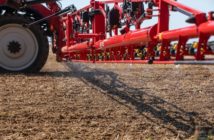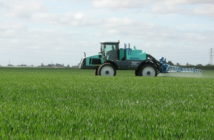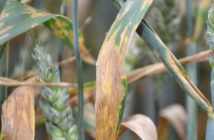A new stewardship group plans to work alongside farmers and operators to ensure best practice for all granular nematicide applications this spring and into the future.
The newly-formed Nematicide Stewardship Programme (NSP) is a joint initiative that brings agrochemical companies Certis, DuPont and Syngenta together for the first time, and includes cross industry support geared to ensure these vital products remain available for future use on potatoes and other key root crops.
Launching a user protocol, a series of workshops aimed at educating users, a tractor cab sticker warning users to ‘stop’ three metres before reaching the row end and an eye-catching logo, the group says it’s determined to work to promote the continued safe application of this product range.
“We’re coming together to pro-actively work within the industry to demonstrate best practice,” says Neil Beadle, DuPont, one of the NSP’s spokesmen. “There’s no doubt that we need to reach out to all operators, be they farmers, contractors or farm workers, to ensure they are fully up to speed with the correct way to both handle and apply these chemicals.”
In common with many ‘actives’ the nematicide product group has come under the scrutiny of European legislators who are increasingly reducing the choices open to farmers keen to protect their crops from a wide range of pests, weeds and diseases.
“We must use every opportunity to ensure, as always, that products are used responsibly, cost-efficiently and in accordance with the manufacturers’ recommendations,” says Neil.
“We’re leading the market from the front. For example, by March 2017, we’re saying that all applicators must be fitted with a device in cab that allows the operator to shut off nematicide granule flow at least 3 metres from the end of each row. This is to ensure no granules are left on the surface as the machine is lifted and turned.
“For those applicators fitted with a hydraulic or electric motor this should already be possible. For those applicators driven by a land or spider wheel an electronic clutch can be fitted to the applicator drive shaft to enable remote shut off.”
The NSP will be running a series of workshops this spring, and again next autumn, aiming to ensure all operators are fully up to date with the latest legislation, and supplied with the correct information that ensures the products are applied accurately and safely.
In addition to the three metre cut off before reaching the row end when applying nematicides, the newly approved protocol, at the centre of these workshops, includes the following key messages:
· Growers must demonstrate that advice has been sought from a BASIS qualified agronomist prior to the purchase and use of a nematicide. Recommendation sheets should be available for each treated field;
· Operators must be qualified to apply granular nematicides (NPTC PA4 or PA4G certification). By March 2017 staff applying nematicides must have completed the Industry Stewardship Training module;
Growers must demonstrate that the granule applicator has been calibrated and checked by a qualified engineer within the last two years:
Cassettes and cartridges (including appropriate rotors) must be appropriate for the accurate application of nematicides:
When applying nematicide growers should keep records to demonstrate that:
1. The applicator is checked prior to each work day, ensuring all pipework is correctly fitted, the hopper bungs are in place and the hopper lids are secure;
2. The applicator is calibrated each week;
3. The area treated and the product volume used match for each field.
“We’ll be encouraging all the 1000-plus operators to attend these workshops, and keeping accurate records so that we can reach out to everyone applying these products,” adds Neil. “We need to ensure nematicides continue to be available to British farmers, and by encouraging stewardship and implementation of best practice, we are confident we are taking steps in the right direction.”
The new NSP protocol will be included in the new Red Tractor potato protocol which will be issued this spring.



